Warded Locks
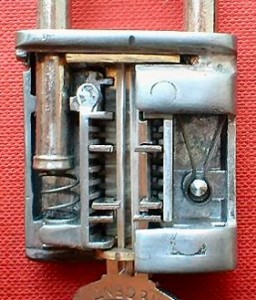 This is one of the oldest designs and, although it appears complex, the mechanism is very simple and easily defeated in under a minute. Inside the lock are simple chambers separated by thin metal walls, called wards. The keys have slots cut so the key can rotate freely, with the ward passing through the cut in the key. In reality, the only security offered by these locks is people’s unfamiliarity with how simple the mechanism actually is. For most locks a thin pick can bypass all of the wards and rotate the actuator in only a few seconds. In addition, there are skeleton key sets for these locks that can be obtained for under $20. These locks offer the least amount of security of all lock designs.
This is one of the oldest designs and, although it appears complex, the mechanism is very simple and easily defeated in under a minute. Inside the lock are simple chambers separated by thin metal walls, called wards. The keys have slots cut so the key can rotate freely, with the ward passing through the cut in the key. In reality, the only security offered by these locks is people’s unfamiliarity with how simple the mechanism actually is. For most locks a thin pick can bypass all of the wards and rotate the actuator in only a few seconds. In addition, there are skeleton key sets for these locks that can be obtained for under $20. These locks offer the least amount of security of all lock designs.
Wafer Locks
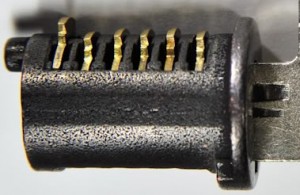 Wafer locks are pretty simple mechanisms and are often used in dirty, high use environments because they are so tolerant of debris and contamination. You will find them on most cars and last for many years with little or no maintenance. Inside are small discs, or wafers that must be raised to a certain height to align and allow the lock to open. Tolerances are usually pretty loose and these are pretty easy to pick. However, there ARE high security versions that have additional grooves cut onto the wafer, called false gates. These are an anti-picking design and many modern cars use these along with a security side bar, that fits into a slot on the side of the wafers once they align properly. These types of locks are NOT easy to pick.
Wafer locks are pretty simple mechanisms and are often used in dirty, high use environments because they are so tolerant of debris and contamination. You will find them on most cars and last for many years with little or no maintenance. Inside are small discs, or wafers that must be raised to a certain height to align and allow the lock to open. Tolerances are usually pretty loose and these are pretty easy to pick. However, there ARE high security versions that have additional grooves cut onto the wafer, called false gates. These are an anti-picking design and many modern cars use these along with a security side bar, that fits into a slot on the side of the wafers once they align properly. These types of locks are NOT easy to pick.
Pin Tumbler
 The pin tumbler is the lock we are most familiar with and it’s the most common type found. It has been in widespread use for almost 100 years and, depending on the manufacturer, can provide medium security. The security of this lock is guided by the number and type of pins in the lock and the number of depths on the key cuts. Most of locks that you’ll try to pick will be pin tumblers.
The pin tumbler is the lock we are most familiar with and it’s the most common type found. It has been in widespread use for almost 100 years and, depending on the manufacturer, can provide medium security. The security of this lock is guided by the number and type of pins in the lock and the number of depths on the key cuts. Most of locks that you’ll try to pick will be pin tumblers.
Tubular Locks
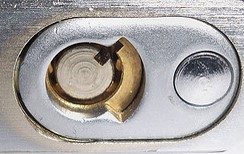 The tubular lock is another common type of lock that’s incorrectly considered “high security”. That assumption is wrong and is usually because of the lock’s obscurity. There are tools that allow these locks to be defeated in less than 1 minute. The ease with which it’s defeated is due to the low number of pins and the depth settings. The more complex and expensive of those is the Peterson Pro-1: (25) Review: Peterson Pro-1 Tubular Lock Pick. A cheaper and faster way to pick open most tubular locks is the SouthOrd Pick: (17) Beating the American Series 7260 7-Pin Tubular Lock. As time passes these are seen less and less. There are high security versions of this style of lock, most notably the Van lock which is used on vending and gambling machines. Still, the Van is pickable as well, as seen in this video: (396) VAN High Security Cam Lock Picked w/Opening Tips.
The tubular lock is another common type of lock that’s incorrectly considered “high security”. That assumption is wrong and is usually because of the lock’s obscurity. There are tools that allow these locks to be defeated in less than 1 minute. The ease with which it’s defeated is due to the low number of pins and the depth settings. The more complex and expensive of those is the Peterson Pro-1: (25) Review: Peterson Pro-1 Tubular Lock Pick. A cheaper and faster way to pick open most tubular locks is the SouthOrd Pick: (17) Beating the American Series 7260 7-Pin Tubular Lock. As time passes these are seen less and less. There are high security versions of this style of lock, most notably the Van lock which is used on vending and gambling machines. Still, the Van is pickable as well, as seen in this video: (396) VAN High Security Cam Lock Picked w/Opening Tips. Dimple Locks
This is a very common lock in Europe, but isn’t very common in North America. It was designed to prevent manipulation by putting the pins in a very narrow space, thus depriving the lock picker of working area. Unfortunately, there are specialized tools to pick these locks and lock pickers have become quite proficient at opening them quickly, usually in under 2 minutes. Several Chinese companies are selling a dimple lock bump tool: (430) Review: New Tool to Defeat Dimple Locks.
Cross (Zeiss) Locks
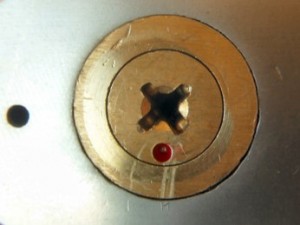 This is the cruciform, or cross lock. In Europe they sometimes call it the “Zeiss” lock, after the original inventor. It’s basically four different (sometimes only three) locks built upon a single key. Because of the compact keyway, the number of depths of cut for the key is reduced, making it a little easier to pick. You can pick them manually: (133) Concept 15-Pin Cruciform Cross Cylinder SPP’d, by raking (253) How to Pick Cross (Zeiss) Locks, or using Cruciform Jiggler keys: (106) Review: Cross Tryout Keys.
This is the cruciform, or cross lock. In Europe they sometimes call it the “Zeiss” lock, after the original inventor. It’s basically four different (sometimes only three) locks built upon a single key. Because of the compact keyway, the number of depths of cut for the key is reduced, making it a little easier to pick. You can pick them manually: (133) Concept 15-Pin Cruciform Cross Cylinder SPP’d, by raking (253) How to Pick Cross (Zeiss) Locks, or using Cruciform Jiggler keys: (106) Review: Cross Tryout Keys.
Interactive Dimple (Mul-T-Lock)
 This is a modern high security lock manufactured by Mul-T-Lock Corporation. There are a number of different models with increasing levels of picking difficulty. One of the easiest to pick is the G-Series: (146) Mul-T-Lock Garrison Lock (6-Pin) SPP’d. The Interactive model has a unique pin that cannot be “read” visually, instead custom forming only once it’s inside the lock. Still, they are possible to pick: (398) Mul-T-Lock Interactive Picked & Gutted + Opening Tips. The top of the line model is the MT-5+ and offers the highest level of security. I have not yet been able to pick one of these.
This is a modern high security lock manufactured by Mul-T-Lock Corporation. There are a number of different models with increasing levels of picking difficulty. One of the easiest to pick is the G-Series: (146) Mul-T-Lock Garrison Lock (6-Pin) SPP’d. The Interactive model has a unique pin that cannot be “read” visually, instead custom forming only once it’s inside the lock. Still, they are possible to pick: (398) Mul-T-Lock Interactive Picked & Gutted + Opening Tips. The top of the line model is the MT-5+ and offers the highest level of security. I have not yet been able to pick one of these.
Bi-Axial (Medeco)
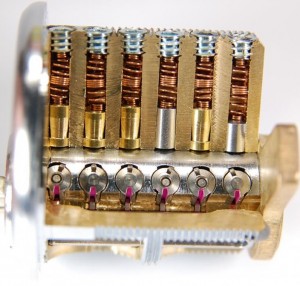 Medeco locks are some of the highest security locks available. They are so secure that the Military used a pair of 6-pin Medeco-cored locks to secure nuclear weapon magazines. For conventional ammunition and weapons storage rooms, a single Medeco is enough.
Medeco locks are some of the highest security locks available. They are so secure that the Military used a pair of 6-pin Medeco-cored locks to secure nuclear weapon magazines. For conventional ammunition and weapons storage rooms, a single Medeco is enough.Still, it’s possible to pick them but they are, by far, the most difficult-to-pick locks I know of. Even on my best day my success rate is pretty low. Still: (174) Medeco 6-Pin Mortise Cylinder Picked Open & Gutted, and (164) Medeco BiAaxial Picked Open & Gutted. Still, it IS possible to occasionally get very, very lucky: (540) Rake Open Medeco Locks? YES!.
Disc Detainers (Abloy)
 This is a disc detainer lock, one of the most secure and pick resistant locks made today. This simple (and cheap to manufacture) design contains discs that must be rotated to a precise angle (every 11-16 degrees is a possible gate cut). If a single disc is misaligned, the lock will not open. It contains no springs or other mechanism to provide feedback to the lock picker.
This is a disc detainer lock, one of the most secure and pick resistant locks made today. This simple (and cheap to manufacture) design contains discs that must be rotated to a precise angle (every 11-16 degrees is a possible gate cut). If a single disc is misaligned, the lock will not open. It contains no springs or other mechanism to provide feedback to the lock picker.
The Abloy brand disc detainer is the top of the line and offers the highest level of security of all locks. I have never been able to pick an Abloy disc detainer, nor do I know of anyone that can. If you want the ultimate high security lock, look no further than an Abloy.
There are lesser quality copies of the Abloy design. These knock-offs are cheaper, contain fewer discs, are made from inferior materials, and don’t contain the anti-picking features. Obviously, they are MUCH easier to compromise. For physical attacks, check these out:
- (12) Defeat Chinese Disc Detainers by Exploiting Their Design Defects
- (13) Defeat Deo Disc Detainer Padlocks by Exploiting a Design Defect
- (14) Defeat Fuloy Disc Detainer Padlock by Exploiting a Design Defect
- (15) Defeat Hermex Disc Detainer Padlock by Exploiting a Design Defect
- (16) Defeat Kiko Disc Detainer Padlock by Exploiting a Design Defect
A known design defect in disc detainer locks is the core’s vulnerability to torque. It takes quite a strong tool to twist the core until it breaks, but it’s possible: (35) Defeating Chinese Disc Detainer Locks using Torque Tool.
There are several Chinese distributors offering disc detainer picks for sale. With a bit of practice you’ll be able to pick open many off-brand disc detainers, but NOT Abloy. Check out this video to see how Chinese copies of the Abloy design can be to pick open. (413) Teshan Disc Detainer Padlock Picked.